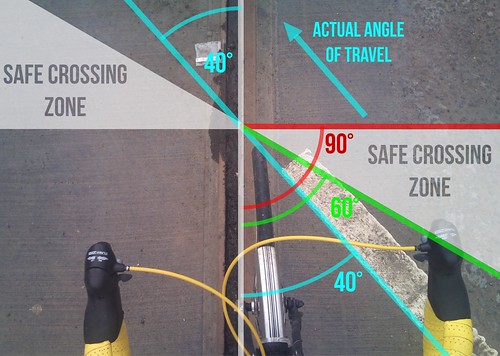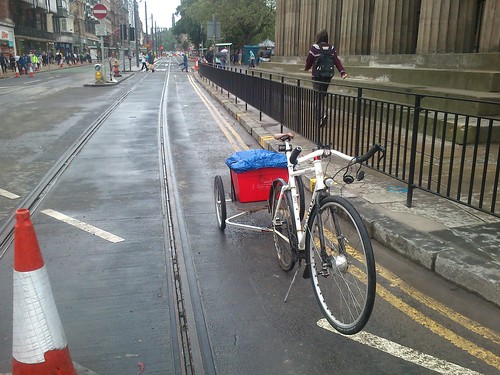Here are a couple of pictures of the rail profiles at the Waverley Bridge/Princes Street Junction, and at Haymarket Tram Stop, plus the page from the Tactile Paving Manual, and an extract from MVA report (1996) on Cycling with Trams. The latter refers to a standard which called for new rails to be, as far as possible flush with the road surface and a tolerance on vertical features of 3mm for sealing, and 6mm for thermoplastic lining p.11 of this report, and notes for NET system call this up as a tolerance of +0mm to -6mm so that the railhead is never proud of the street surface (to lift up a rubber tyre clear of the friction of abutting road surfaces).
The case of Roe vs Sheffield Supertram & others relates to rails raised above the road surface - very much as in the picture of the Waverley Bridge Junction - where a car driver claimed that all 4 tyres were lifted clear of the road surface and slid along the rails. from the pictures it seems possible that this could occur with the rails projecting that far above the road surface, unless a very thin additional detail was missing when the photograph was taken.
To take a picture or the profile use a handy 'straightedge' and a coin to scale against it 5p=18mm 1p=21mm 2p=25mm. The sheer number and scale of the vertical discontinuities across the band containing the rail embedding system substantially enhance the hazard resulting from striking a vertical edge greater than 5mm high at any oblique angle.
Waverley Junction profile detail
https://www.dropbox.com/s/rjs12ow7zxu6ctf/Princes%20St%20%28Waverley%20Br%20Junction%29P1010577-extract.JPG
Haymarket
https://www.dropbox.com/s/bsowll0ix49x39h/Haymarket%20profile%20P1010678-extract.JPG
Tactile Paving spec
https://www.dropbox.com/s/9e5v4sjsfr480y7/tactilepavement%20tramline%20p.54.jpg
Getting the detailing right is important. Manchester suffered sagging rails and edge blocks moving, because of a flaw in specifying the flexible pad under the rails, the new system seems to be an improvement, and Sheffield now has a major task in their rail renewal posing a significant challenge in cutting out the old rails.
Interestingly from the 1996 MVA study surveys of cycle traffic on streets where cycling was banned, along with all other vehicle traffic to facilitate the tram route showed levels of cycling similar to the open streets and no increased incidence of cyclists' falls.
It will also be interesting to see the detailing of off street tram stops, and cycle route crossings in the light of a recent incidents in Croydon (2012) and Manchester (2011), plus a run of inquiries into cyclists killed by trams and trains with clear indications that each one had been wearing headphones and rode across the tracks completely oblivious to the tram or train bearing down on them.
Sorry I hit the limit on inserted URL and nonsense was coming out. Other stuff by e-mail





 posts
posts
